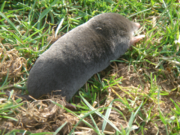Mole (animal)
2008/9 Schools Wikipedia Selection. Related subjects: Mammals
| Moles | ||||||||||
|---|---|---|---|---|---|---|---|---|---|---|
 |
||||||||||
| Scientific classification | ||||||||||
|
||||||||||
| Genera | ||||||||||
|
17 genera, see text |
Moles are members of the family (Talpidae) of mammals in the order Soricomorpha that live underground, burrowing holes. Some species are aquatic or semi-aquatic. They have cylindrical bodies covered in fur with small or covered eyes; the ears are generally not visible. They feed on small invertebrate animals living underground. Moles can be found in North America, Europe, Asia and the eastern seaboard of Australia.
Male moles are called boars, females are called sows. A group of moles is called a labour.
Diet
A mole's diet is primarily composed of earthworms and other small invertebrates. The mole will also occasionally catch small mice at the entrance to its burrow. Once the food is caught, the mole will either store it for later or feed it to its young.
The Star-nosed Mole can detect, catch and eat food faster than the human eye can follow (under 300 milliseconds).
Evolution
Darwin cites moles as an example of organs being phased out:
The eyes of moles and of some burrowing rodents are rudimentary in size, and in some cases are quite covered by skin and fur. This state of the eyes is probably due to gradual reduction from disuse, but aided perhaps by natural selection. In South America, a burrowing rodent, the tuco-tuco, or Ctenomys, is even more subterranean in its habits than the mole; and I was assured by a Spaniard, who had often caught them, that they were frequently blind. One which I kept alive was certainly in this condition, the cause, as appeared on dissection, having been inflammation of the nictitating membrane. As frequent inflammation of the eyes must be injurious to any animal, and as eyes are certainly not necessary to animals having subterranean habits, a reduction in their size, with the adhesion of the eyelids and growth of fur over them, might in such case be an advantage; and if so, natural selection would aid the effects of disuse. (Charles Darwin, The Origin of Species, Laws of Variation)
Classification
The family is divided into 3 subfamilies, 7 tribes, and 17 genera:
- Subfamily Scalopinae
- Tribe Condylurini
- Genus Condylura
- Tribe Scalopini
- Genus Parascalops
- Genus Scalopus
- Genus Scapanulus
- Genus Scapanus
- Tribe Condylurini
- Subfamily Talpinae
- Tribe Desmanini
- Genus Desmana
- Genus Galemys
- Tribe Neurotrichini
- Genus Neurotrichus
- Tribe Scaptonychini
- Genus Scaptonyx
- Tribe Talpini
- Genus Euroscaptor
- Genus Mogera
- Genus Parascaptor
- Genus Scaptochirus
- Genus Talpa
- Tribe Urotrichini
- Genus Dymecodon
- Genus Urotrichus
- Tribe Desmanini
- Subfamily Uropsilinae
- Genus Uropsilus
Pest status
Moles are considered to be an agricultural pest in some countries, while in others such as Germany they are a protected species. Problems caused are cited as contamination of silage with soil particles making it unpalatable to animals, the covering of pasture with fresh soil reducing its size and yield , damage to agricultural machinery by the exposure of stones, damage to young plants through disturbance of the soil, weed invasion of pasture through exposure of fresh tilled soil, and damage to drainage systems and watercourses. Other species such as weasels and voles may use mole tunnels to gain access to enclosed areas or plant roots.
Moles that burrow in the lawns of humans can disturb the earth, raising molehills and causing enough aesthetic problems to be considered as pests. They do however benefit the soil by aerating and tilling it, adding to its fertility. Contrary to popular belief, moles don't eat plant roots.
They are controlled with traps and poisons such as calcium carbide and strychnine.
Moles are considered to be a very dirty, smelly and filthy animal in India. The Hindi word for a mole, viz., छछुन्दर / tʃʰətʃʰund̪ər /, when used for a man, implies a very filthy and cowardly person.
Similarly named animals
Other similar animals are found in family Chrysochloridae (the golden moles) and family Notoryctidae (the marsupial moles) which are not related to true moles.
There are also similar-looking but herbivorous rodents called mole-rats that lead a similar life-style and are commonly called "moles", although, unlike mole-rats, no species of true mole is known to be eusocial.
Trivia
- Contrary to what many believe, moles do not hibernate. Having to eat their own body weight daily, their metabolism will not allow them to store fat. As the surface of the ground gets cold, their food source goes deeper -- so does the mole.
- The silky fur of mole, moleskin, was originally being used in bounding the famous moleskine notebooks.
- Even though the soft mole is considered to be small and helpless, it is said to have caused the death of William III of England in 1702, when he fell from his horse after it stumbled over a mole hill.
- Many types of earth-burrowing machines take their names from moles.
- An adult mole has 44 teeth, one of the largest number for a terrestrial mammal.
- Dogs have been known to dig moles out of the ground and bite them to death.
- One of British comedian Jasper Carrott's sketches involves him trying to get rid of a mole that had moved into to his garden, at one point, as he described, trying to use a shotgun, a swirling chair, and a torch.
- In a study done in 2007 in the Lake District, UK, an average mole hill weight was calculated to be about 4.5 kg.


